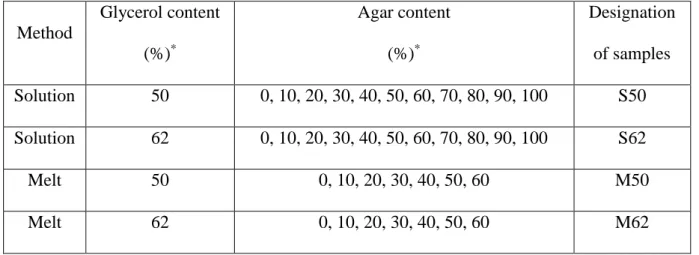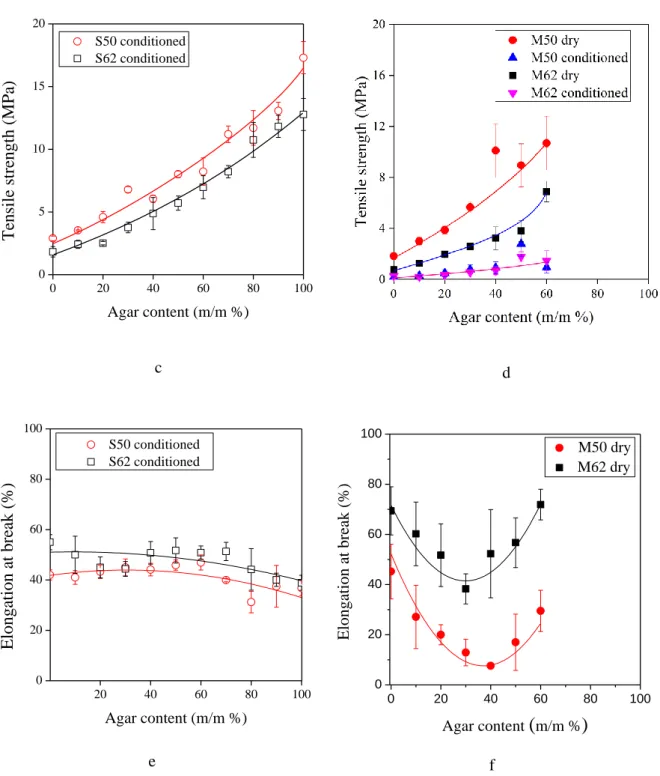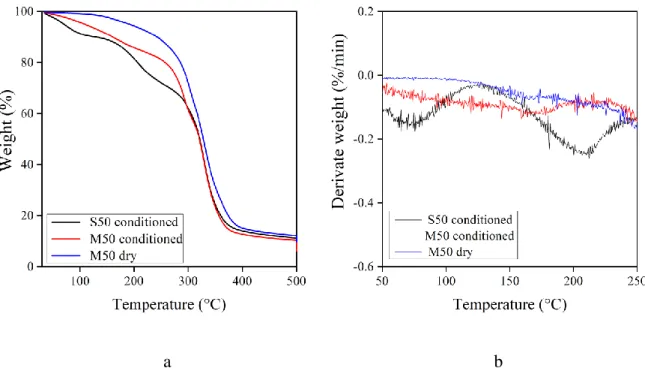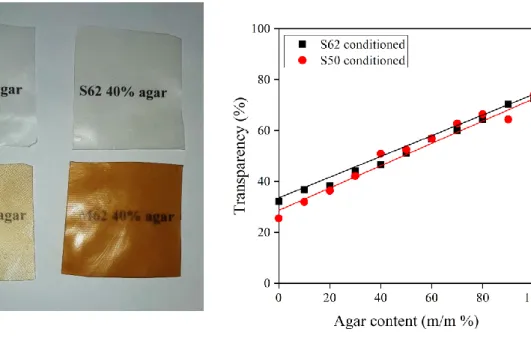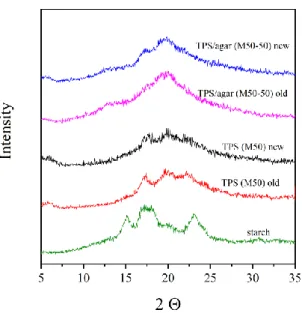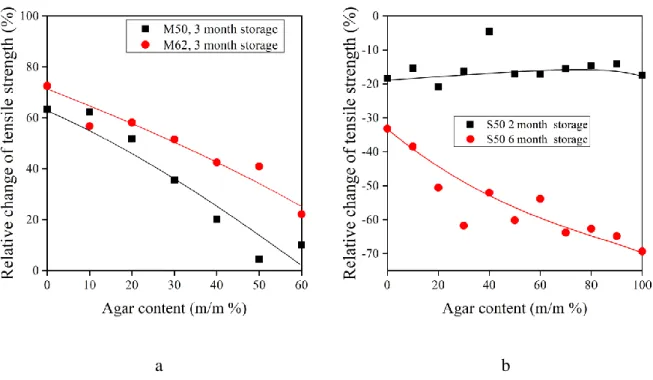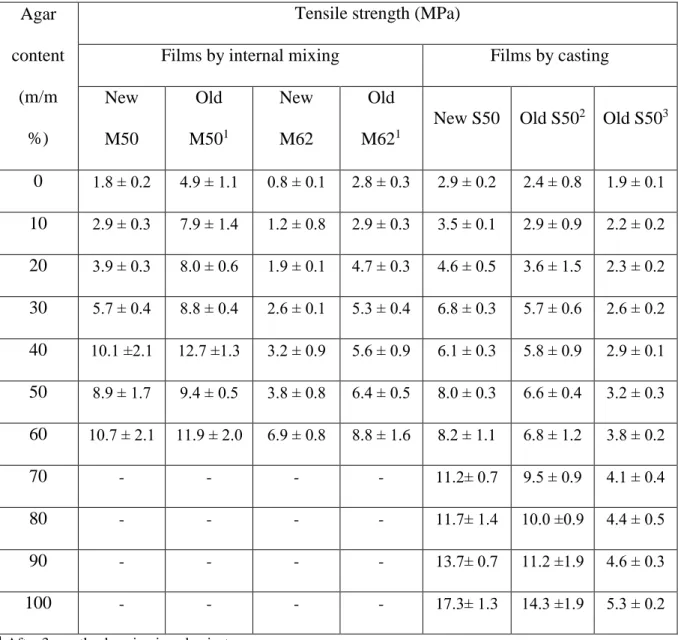International Journal of Biological Macromolecules Volume 136, 1 September 2019, Pages 1026-1033
https://doi.org/10.1016/j.ijbiomac.2019.06.109
Improving physical properties and retrogradation of thermoplastic starch by incorporating agar
Erika Fekete1,2*, Éva Bella1,2, Emília Csiszár2, János Móczó1,2
1 Institute of Materials and Environmental Chemistry, Research Centre for Natural Sciences, Hungarian Academy of Sciences, H-1117 Budapest, Magyar tudósok körútja 2., Hungary
2 Laboratory of Plastics and Rubber Technology, Department of Physical Chemistry and Materials Science, Budapest University of Technology and Economics, H-1111 Budapest,
Műegyetem rkp. 3., Hungary
*Corresponding author: Phone: +36-1-463-4335, Fax: +36-1-463-3474, Email:
ebodine@mail.bme.hu
2 Abstract
To develop functional and sustainable packaging materials from starch and to enhance their properties, agar was added to thermoplastic corn starch (TPS) in a wide concentration range and the products were prepared either by casting or melt blending with a high glycerol content. The role of agar in the mechanical and barrier performance of films, as well as the compatibility of TPS and agar was systematically evaluated. In addition, the retrogradiation of starch in various blends after long storage periods was widely characterized. Results proved that the addition of agar to TPS resulted in films with promising barrier and tensile properties. Stiffness and strength increased considerably by increasing agar content, while deformability of blends was better than those of pure TPS. Agar incorporation decreased water permeability and solubility and improved light transmittance. Retrogradation of the dry blends was significantly smaller than that of pure TPS owing to the strong starch/agar interaction.
Keywords: TPS/Agar blend, Compatibility, Retrogradation
1. Introduction
Recently, there has been a growing interest in the application of biopolymers in order to reduce the environmental pollution caused by plastic waste and to achieve sustainable development. The most promising renewable polymers, such as cellulose, starch, chitosan, agar or alginates, are polysaccharides. Various products like films, nanoparticles, gels and scaffolds are usually developed from both the neat polymers, as well as from their blends and composites.
They are widely used in the packaging, agricultural, healthcare and medical areas [1-13]. In the field of packaging, the most commonly used biopolymer is starch.
3
Starch is a semi-crystalline polymer with a repeating unit of -D glucopyranose. It consists of two macromolecules: amylose and amylopectin, with a linear and a highly branched molecular structure, respectively [14, 15]. The predominant crystalline component in starch is amylopectin. The relative amounts of amylose and amylopectin depend on the botanical source and strongly determine the properties of starch. Corn starch granules typically contain approximately 70 % of amylopectin and 30% of amylose [15].
Starch has to be plasticized due to its poor processing ability [14]. Plasticization transforms the semi-crystalline granules into a homogeneous, rather amorphous material by destroying the hydrogen bonding network between the starch molecules and by synchronous formation of hydrogen bonds between the plasticizer and the starch molecules. Polyols like glycerol and sorbitol are commonly used as efficient plasticizers for starch. Granular disruption can be achieved in the presence of a plasticizer by applying film casting or thermomechanical energy for example in a continuous and cost effective extrusion process [14, 15].
The main disadvantages of plasticized starch (TPS) are the pronounced hydrophilic character and the inadequate mechanical properties. During storage, the water/polyol plasticized starch can undergo a recrystallization process, called retrogradation [16, 17].
Retrogradation modifies several properties (e.g. opacity, hardness, deformability, dimensional stability, etc.), thus, the shelf-life and the quality of the final products are strongly affected by it.
The rate of retrogradation depends on the glass-transition temperature of TPS, which is determined by the type and amount of plasticizers (glycerol, water) in the polymer [9, 16-18].
It is well-known that water is a good plasticizer of starch. Since the glycerol plasticized starch is very hydrophilic, the mechanical properties of TPS strongly depend on the water content.
After thermomechanical processing, TPS completely lacks water, but during storage water absorption occurs immediately. As a consequence, the properties of TPS are determined by
4
retrogradation and water absorption. Through restraining the mobility of starch molecules, additives like non-starch polysaccharides (e.g. alginate, carboxymethyl cellulose and guar gum) were highly efficient in preventing the retrogradation of starch films [9, 11, 17, 19, 20].
One of the potential polysaccharides to reduce retrogradation of TPS is agar, which is a gelatinous product from the red algae class (Rhodophyceae). Agar is a heterogeneous complex mixture of the related polysaccharides having the same backbone chain structure. The main components of the chain are D-galactopyranose and 3,6-anhydro-L-galactopyranose with alternating (1,4) and (1,3) linkages. Agar is lightly sulfated; the main fraction is agarose, a neutral polymer, while the agaropectin is a sulfated polymer. Depending on the source, the molecular weight varies from 80 000 to 140 000 g/mol. Agar is insoluble in cold water and slightly soluble in ethanolamine, whereas in the dried state it is soluble in hot water [10, 11].
Polysaccharide-based film-forming materials, such as starch and starch derivatives, cellulose derivatives, alginate, carrageenan, chitosan, pectin and various gums have been studied extensively for developing edible packaging systems. Although several papers have been published in the field of edible films made from starch and agar [11, 19, 21-24] and some of them discussed the properties of blends prepared by melt blending [21-24], but less information is available on blends prepared in a wide composition range and on the correlation between the agar content and the retrogradation of TPS [19]. Thus, the present paper aims at the elucidation of the effect of agar addition on the structure, properties and tendency of TPS retrogradation. TPS-agar blend films were prepared in a wide range of concentration either by solution or melt blending with extremely high glycerol content. For the comparative characterization of films, scanning electron microscopy, X-ray diffraction, UV–vis spectroscopy, tensile test and thermogravimetric analysis, water vapour permeability, as well as some simple tests were applied. The results proved that certain properties of TPS films can
5
be enhanced, while retrogradation of starch can be suppressed by the addition of agar. Thus, the blending of TPS and agar enabled the tailoring of film properties for several applications.
2. Experimental 2.1. Materials
Corn starch with a water content of 12 wt%, produced by Hungrana Ltd. (Hungary) was used in the experiments. Glycerol with 0.5 wt% water content was obtained from Molar Chemicals Ltd. Hungary and was used without further purification or drying. Agar powder (with ash content: 2-4.5%) was supplied by Sigma Aldrich, Hungary.
2.2. Preparation of plasticized TPS/agar blends
In order to investigate retrogradation, TPS blend films were prepared by solution or melt blending with an extremely high glycerol content. Solution blending was carried out as follows.
Briefly, native starch was dispersed in distilled water containing either 50 or 62 wt % of glycerol, based on the total amount of dry carbohydrates (starch plus agar). To gelatinize the starch granules, the suspension was continuously stirred at 80 °C for 30 min. Agar was added to the gelatinized starch and the mixture was stirred for another 30 min at 80 °C, and agar-TPS film was obtained by casting the hot suspension into a Petri dish covered by a Teflon sheet and subsequently drying it in a humidity chamber at 35 °C and 50 RH% for 24 h. The agar content was changed in a wide composition range (from 0 to 100%) on the dry basis of polysaccharide.
Thickness of the films was 100 ± 20 µm. Prior to the analysis, the films were stored at 23 °C and 50 % RH.
Preparation of TPS/agar films by melt blending was carried out in an internal mixer (Brabender W50 EH). The starch was premixed with glycerol and agar in a Petri dish for 30 min, then the mixture was introduced into the mixer and was homogenized at 135 °C and 50 rpm for 10 min. The agar content was changed between 0 and 60 % and based on the dry weight
6
of polysaccharide. A plate with an averaged thickness of 400 ± 30 µm was compression moulded from the melted mixture at 135 °C for 4 min. One half of the film prepared by melt mixing was stored under dry conditions (at 0 RH%), while the other was stored at 23 °C and 50
% RH until further study. Table 1 contains the list of blends, their compositions and the methods applied for their preparation.
Table 1. Preparation method, composition and designation of the TPS blends
Method
Glycerol content (%)*
Agar content (%)*
Designation of samples Solution 50 0, 10, 20, 30, 40, 50, 60, 70, 80, 90, 100 S50 Solution 62 0, 10, 20, 30, 40, 50, 60, 70, 80, 90, 100 S62
Melt 50 0, 10, 20, 30, 40, 50, 60 M50
Melt 62 0, 10, 20, 30, 40, 50, 60 M62
* Based on the total amount of dry carbohydrates (starch + agar).
2.3. Characterization
Crystalline structure of the TPS and blends was studied by X-ray diffraction (XRD) using a Philips PW1830/PW1050 equipment with CuKα radiation at 40 kV and 35 mA. Samples were scanned in the diffraction angle range of 2–35° in 0.04° steps. Diffractograms were recorded on the powders (starch) or films using a multipurpose sample stage. Morphology of the samples was examined by scanning electron microscopy (SEM) using a Jeol JSM 6380 apparatus. The micrographs were taken from the surfaces created by cutting with an ultramicrotome. The light transmission of films at 700 nm was determined using an UV-VIS spectrometer (Unicam W500).
Water content of the conditioned films prepared by different methods was determined by thermogravimetric analysis (TGA), using a Perkin Elmer TGA 6 equipment from 35 to 700
7
°C, at a heating rate of 10 °C/min, under nitrogen flow. Tensile properties (Young’s modulus, tensile strength and elongation at break) were measured by an Instron 5566 apparatus according to ISO 527/4A. Young’s modulus was determined at 0.5 mm/min while ultimate properties at a cross-head speed of 5 mm/min. All characteristics derived from five parallel measurements.
To investigate retrogradiation, selected samples were characterized immediately after sample preparation and also after storage under controlled condition for 2, 3 and 6 months.
Water vapour permeability (WVP) of films prepared by casting was investigated at a relative humidity difference of 100-50 %. The film was placed between two metal rings on the top of a glass cell containing distilled water, then the glass cell was introduced into a climate- controlled chamber regulated at 50 % RH and 23 °C. The test cell was periodically weighted to a constant variation rate of weight. WVP (g m-1s-1Pa-1) was calculated using the Equation 1, where m is the weight loss (g) of the test cell, x is the film thickness (m) and A is the exposed area (m2) during t duration (s) under p partial water vapour pressure (Pa)
WVP = m x / A t p (1) The solubility of TPS/agar blends in water was determined by measuring periodically the mass of the samples stored in distilled water at 40 °C.
3. Results and discussion 3.1. Mechanical properties
The TPS/agar blends prepared either by solution or melt mixing had homogeneous appearance without breaks, fractures and perceptible particles or bubbles. Owing to the high plasticizer content, the films were flexible and easy to handle. To characterize the mechanical behaviour of composites, stiffness (Young’s modulus), strength (tensile strength) and deformability (elongation at break) of the conditioned films prepared by casting or melt
8
blending were determined. Composition dependence of the Young’s modulus, tensile strength and elongation-at-break values are plotted in Fig. 1. All properties are shown separately for films prepared either by casting (Fig. 1a, Fig. 1c, Fig. 1e) or melt blending (Fig. 1b, Fig. 1d, Fig. 1f). The films were successfully prepared by casting in the entire composition range.
However, melt blended films could be developed only in a narrower concentration range (0 – 60 % agar content, Table 1), since the addition of agar significantly increased the stiffness of TPS.
Addition of agar significantly increases not only the stiffness but also the strength of TPS (Figs. 1a-d). By comparing the data of films prepared with the same composition but different methods (casting or melt blending), it is obvious that the dry blends prepared by melt mixing have a higher modulus than the cast films. Nevertheless, the tensile strengths of the differently prepared samples are almost the same.
Furthermore, the results in Figs. 1a-d prove that the stiffness and strength strongly depend on the plasticizer content. Besides glycerol, the cast films contain also water derived from preparation and conditioning and water has a strong plasticizing effect. That can be the reason why the conditioned cast films with the same polysaccharide and glycerol content have a lower Young’s modulus than the dry blends prepared in the internal mixer. Despite the comparable glycerol and water content of S50 and S62 blends, the stiffness and strength of the conditioned M50 and M62 films are very poor; in fact they are the worst among all samples.
The reason behind this might be that water is differently bonded during solution mixing and conditioning and it shows a different effect on the mechanical properties. Similar results were obtained earlier for TPS/montmorillonite composites [13].
Surprisingly, the composition dependence of deformability of cast films and dry melt blended films was quite different (Figs. 1e,f). While the changes in elongation at break as a function of agar content can be understood and explained for the samples M50 and M62 (Fig.
9
1f), interpretation of the results for S50 and S62 blends (Fig. 1e) is more difficult. Larger plasticizer content results in higher elongation at break in M50 and M62 samples and the deformability decreases with increasing agar amount until 30-40% agar content, which is consistent with the tensile strength results. The varying composition dependence of the deformability of cast films could be due to the high water and glycerol content. For a more detailed explanation, further studies would be necessary.
a b
10
0 20 40 60 80 100
0 5 10 15 20
S50 conditioned S62 conditioned
Tensile strength (MPa)
Agar content (m/m %)
c d
20 40 60 80 100
0 20 40 60 80 100
S50 conditioned S62 conditioned
Elongation at break (%)
Agar content (m/m %) e
0 20 40 60 80 100
0 20 40 60 80 100
M50 dry M62 dry
Elongation at break (%)
Agar content (m/m %)
f
Fig. 1. Effect of agar content on Young's modulus (a, b), tensile strength (c, d) and elongation at break (e, f) of films prepared by casting (a, c, e) or melt mixing (b, d, f). (Lines are drawn only to guide the eye and they are not fitted correlations.)
In order to check whether water is bonded differently during solvent mixing and conditioning, thermogravimetric analysis was carried out for films prepared by casting or melt
11
mixing. Samples prepared by melt mixing were investigated in dry and conditioned forms as well. TGA and DTGA curves in Fig. 2a and b, respectively, demonstrate the weight loss and derivate of weight loss of selected films up to 250 °C. For the dry M50 film, only minimal weight loss was observed that can be explained by the slight evaporation of glycerol. For the conditioned M50 and S50 films, however, the weight loss is larger and one or two steps, respectively, can be observed on the TGA curves. We suppose that the reason of the two steps on the TGA curve of S50 sample (two peaks on DTGA) is that the conditioned cast film contains not only water absorbed on the surface but also water bound in the bulk (i.e. structurally bound water). Obviously, the two kinds of water can be evaporated at different temperature. These results support our assumption on the differently bonded water in films, which presumption could also be confirmed by previous publication [25]. However, the conditioned sample which was prepared by melt mixing (M50 conditioned) restrains only water bound on the surface.
a b
Fig. 2. TGA (a) and DTGA (b) traces of TPS samples (S50 cast film and M50 dry and conditioned samples)
12 3.2. Compatibility of TPS and agar
3.2.1. Composition dependence of the strength
The use of a simple, previously developed semi-empirical model [26, 27] allows us to predict the miscibility of polymers from the tensile strength of the blends. The model takes the following (2) form for tensile strength:
T = T0 n ((1 - ) / (1 + 2.5)) exp (B) (2)
where T and T0 are the true tensile strength (T = and = L/L0) of the composite and the matrix, respectively, n is a parameter taking into account strain hardening, is the volume fraction of the filler and B is related to its relative load carried by the dispersed component.
Parameter B is determined by the component interaction as well as the inherent properties of them (Equation 3):
B = ln (C Td /T0) (3)
where Td is the strength of the dispersed phase, while C is related to the stress transfer between the phases, i.e. interactions. Furthermore, according to previous results, parameter C shows an inverse correlation to the Flory–Huggins interaction parameter () [28-32], as proved for a number of polymers in Fig. 3a. [28-30] Appropriate rearrangement of the model equation, calculation and logarithm of reduced strength (Tred = exp (B)) yields straight lines as a function of the volume fraction of dispersed component. The tensile strength of the S62 blends was plotted in this form in Fig. 3b.
13
a b
Fig. 3. General correlation between C parameter and Flory-Huggins interaction parameter for various polymer-pairs (a); Determination of parameters B and C of S62 blends (b).
Straight lines with a good fit were obtained for the selected samples, the slopes of which express the parameter B. Two different B parameters could be calculated for each type of blends depending on the matrix polymer. In case of e.g. the S62 blends, B is 5.63 for the TPS matrix and 1.61 for the agar matrix. Table 2 shows the B and C parameters determined for all blends.
As the agar strength in blends prepared in internal mixer is unknown, the C parameters for M50 and M62 blends could not be calculated. According to the former results introduced in Fig. 3a, C parameters higher than 30 indicate negative Flory-Huggins parameters, which predict good compatibility, probably miscibility of starch and agar.
14
Table 2. Calculated B and C parameters for selected blends and the Flory-Huggins interaction parameters () estimated by Fig. 3a.
Sample Matrix B parameter C parameter
Estimated
parameter S50
TPS 5.00 33.40 -0,3
Agar 2.28 43.44 -0.9
S62
TPS 5.63 39.68 -0.7
Agar 1.61 34.92 -0.4
Dry M50 TPS 8.47 - -
Dry M62 TPS 8.57 - -
3.2.2. Discoloration and light transmission
The TPS/agar blends prepared by solution or melt mixing were about transparent, but they differed in colour significantly. While the cast films are white, the films prepared by compression moulding have a brownish colour (Fig. 4a). Discolouration of the latter films can be attributed to the formation of various chromophoric systems, like conjugated double bonds and carbonyl groups. The brownish colour of samples might be related to the heat induced degradation of starch and agar during melt mixing performed at an elevated temperature.
The transparency of films depended on some factors such as composition (i.e. starch/agar content, concentration of plasticiser) and method of preparation (i.e. solution or melt mixing) [13, 30, 33]. As the data in Fig. 4b reveal, the transmittance of the cast films (S62 and S50) shows a linear dependence to the composition of the blends, suggesting a good compatibility of the starch-agar polymers. It is well-known that light transmission data can provide information on compatibility of components. Miscible polymers forms blends with homogeneous structure, while incompatible polymers create heterogeneous blends. The blends containing dispersed
15
particles that are smaller than the wavelength of incident light are transparent, while larger ones scatter light making the material opaque [34]. Composition dependence of the blend properties helps also to assess the compatibility, since in case of bad compatibility, a given property of the blend is below the additive values of that property. The adequate light transmittance of the blends and the linear correlation between transmittance and composition of the cast films demonstrate good compatibility of the starch-agar polymers. Similar conclusion can also be drawn for miscibility and compatibility of the blend components based on the SEM micrographs (not presented), since all the blends investigated have a homogeneous structure.
a b
Fig. 4. Effect of composition and preparation method on the colour (a) and transparency (b) of the TPS/agar blends.
3.3. Solubility and the water vapour permeability of TPS/agar blends
Besides appearance and mechanical properties, the solubility and water permeability are also of importance for a packaging material. It is well known that the strong hydrophilic
16
character of TPS results in large water permeability and solubility. It is clear from the above presented results that agar improves the mechanical properties as well as the light transmittance of TPS. Based on the C parameters and Flory-Huggins interaction parameters estimated (Table 2), there is a strong interaction between starch and agar that can decrease the free volume of polymers and can cause a lower water permeability and solubility. Water permeability of cast blends is presented in Fig. 5. Based on these results, it can be concluded that the permeability of TPS/agar blends is smaller than that of the pure polymer component. Although, the measured WVP values show considerable scatter, there is a clear tendency for the composition dependence of permeability and as expected, water vapour permeability decreases with increasing the glycerol content. The strong interaction between the blend components diminishes the free volume for water diffusion, resulting in a lower permeability.
Fig. 5. Water vapour permeability of the TPS agar blends at a relative humidity difference of 100-50 % as a function of agar content. (Lines are drawn only to guide the eye and they are not fitted correlations.)
17
For the characterization of solubility, the TPS/agar samples containing 0, 10 and 50 m/m
% agar were kept in water at 40°C and the mass of samples was measured periodically for 3 months. Unfortunately, accurate determination of the mass change of the neat TPS samples was not possible, as after some hours the films became so mushy that they could not be taken out of the water. After some weeks the samples disaggregated. In contrast, the mass of the samples with an agar content increased in the first days and then remained unchanged. Taken all together, the addition of agar to TPS results in better stiffness and strength with good deformability, as well as smaller water permeability and solubility.
3.4. Retrogradation of the TPS/agar blends
Retrogradation of TPS and its blends can be monitored e.g. on the basis of the changes in crystalline structure and mechanical properties. Fig. 6 shows the XRD patterns determined immediately after the sample preparation (new samples) and after 3 month storage (old samples) for starch powder and dry M50 samples containing 0 and 50 % agar (M50-50). It is clearly visible that the crystallinity of starch significantly decreases during the preparation of TPS, especially in TPS blends. Comparison of patterns of old and new samples (for TPS films with the same composition) suggests that in the case of samples prepared by melt mixing, the addition of agar to TPS decreases retrogradation; furthermore, a higher difference in the patterns of old and new TPS (M50) films can be observed than that of the TPS/agar blends (M50-50).
18
Fig. 6. XRD traces of starch and M50 blends containing 0 and 50 % (M50-50) agar before (new) and after 3 month storage (old)
For further proof, the tensile strength () of the new (new) and old (old) TPS blends were measured (Table 3). Using these results, relative change of these properties were determined. The relative change of tensile strength (rel)gives the difference of new and old films based on of new samples (Equation 4).
rel = (new - old) / old (4)
These quantities are presented as function of agar content in Fig. 7. Based on Fig. 7a, which shows the results determined for dry blends prepared in internal mixer, it is clear that agar decreases the retrogradation of TPS. While the relative change of tensile strength of pure TPS is about 60-70 % depending on glycerol content, this value is only 10-20 % when the blend contains 60 % agar. Different results were observed in the case of cast films. While the tensile strength of dry samples prepared by melt mixing increased, of cast conditioned samples
19
decreased during the storage. After two month, the agar content did not influence the results, but after half a year the absolute value of relative change increased with increasing agar content. In order to interpret these results, the two parallel processes taking place during the storage of cast conditioned films need to be taken into account: retrogradation and water uptake.
While retrogradation increases it, water uptake decreases the tensile strength. Additionally, water content also influences retrogradation beside the glycerol content. Since water uptake of agar is larger than that of starch and agar diminishes retrogradation (see Fig 7a), the storage of cast films at 50% RH for 6 months leads to the decrease of tensile strength of the blends.
According to Fig. 7b, the effect of water absorption and retrogradation was similar after 2 months. Thus, the agar content did not influence the change in the relative tensile strength.
a b
Fig. 7. Influence of agar content on the relative change of tensile strength of TPS/agar blends as an effect of storage. (a) Dry blends prepared in internal mixer; (b) Casted conditioned blends.
(Lines are drawn only to guide the eye and they are not fitted correlations.)
20
Table 3. Tensile strength of TPS/agar blends measured immediately after the sample preparation (new) and after several month storage (old)
Agar content
(m/m
%)
Tensile strength (MPa)
Films by internal mixing Films by casting New
M50
Old M501
New M62
Old M621
New S50 Old S502 Old S503
0 1.8 ± 0.2 4.9 ± 1.1 0.8 ± 0.1 2.8 ± 0.3 2.9 ± 0.2 2.4 ± 0.8 1.9 ± 0.1 10 2.9 ± 0.3 7.9 ± 1.4 1.2 ± 0.8 2.9 ± 0.3 3.5 ± 0.1 2.9 ± 0.9 2.2 ± 0.2 20 3.9 ± 0.3 8.0 ± 0.6 1.9 ± 0.1 4.7 ± 0.3 4.6 ± 0.5 3.6 ± 1.5 2.3 ± 0.2 30 5.7 ± 0.4 8.8 ± 0.4 2.6 ± 0.1 5.3 ± 0.4 6.8 ± 0.3 5.7 ± 0.6 2.6 ± 0.2 40 10.1 ±2.1 12.7 ±1.3 3.2 ± 0.9 5.6 ± 0.9 6.1 ± 0.3 5.8 ± 0.9 2.9 ± 0.1 50 8.9 ± 1.7 9.4 ± 0.5 3.8 ± 0.8 6.4 ± 0.5 8.0 ± 0.3 6.6 ± 0.4 3.2 ± 0.3 60 10.7 ± 2.1 11.9 ± 2.0 6.9 ± 0.8 8.8 ± 1.6 8.2 ± 1.1 6.8 ± 1.2 3.8 ± 0.2
70 - - - - 11.2± 0.7 9.5 ± 0.9 4.1 ± 0.4
80 - - - - 11.7± 1.4 10.0 ±0.9 4.4 ± 0.5
90 - - - - 13.7± 0.7 11.2 ±1.9 4.6 ± 0.3
100 - - - - 17.3± 1.3 14.3 ±1.9 5.3 ± 0.2
1 After 3 months, keeping in a dessicator
2 After 2 months, conditioning in 50 RH%
3 After 6 months, conditioning in 50 RH%
4. Conclusions
The present study on TPS/agar blends shows that agar considerably improves the mechanical properties of TPS. It was observed that Young’s modulus and tensile strength increased as an effect of increasing agar content independently of the processing method. Although, the composition dependence of elongation of break was different for cast films and samples
21
prepared by melt mixing, the deformability of blends was better than that of pure TPS samples having the same strength. Light transparency, SEM images, as well as the composition dependence of water permeability and tensile strength indicate good compatibility, maybe even miscibility of starch and agar. Beside the significant improvement of mechanical properties, agar decreases water permeability and solubility of TPS. As an effect of strong interaction between starch and agar, retrogradation of dry TPS/agar blends prepared by melt mixing was significantly smaller than that of pure TPS. While the strength of these samples increased, cast films during storage at 50 % RH became softer after six month due to the notable water uptake of agar. Since the TPS/agar blends have better mechanical and barrier properties as well as more appropriate structural stability than the TPS alone that makes them suitable for edible packaging materials.
5. Acknowledgement
This work was partly supported by the BME-Biotechnology FIKP grant of EMMI (BME FIKP- BIO).
6. References
[1] P. Cazon, G. Velazquez, J.A. Ramirez, M. Vazquez, Polysaccharide-based films and coatings for food packaging: A review, Food Hydrocolloids 68 (2017) 136-148.
[2] H. Khalil, C.K. Saurabh, Y.Y. Tye, T.K. Lai, A.M. Easa, E. Rosamah, M.R.N. Fazita, M.I.
Syakir, A.S. Adnan, H.M. Fizree, N.A.S. Aprilia, A. Banerjee, Seaweed based sustainable films and composites for food and pharmaceutical applications: A review, Renewable & Sustainable Energy Reviews 77 (2017) 353-362.
[3] S. Ganiari, E. Choulitoudi, V. Oreopoulou, Edible and active films and coatings as carriers of natural antioxidants for lipid food, Trends in Food Science & Technology 68 (2017) 70-82.
22
[4] A.S. Sumayya, G.M. Kurup, Marine macromolecules cross-linked hydrogel scaffolds as physiochemically and biologically favorable entities for tissue engineering applications, Journal of Biomaterials Science-Polymer Edition 28(9) (2017) 807-825.
[5] R. Zafar, K.M. Zia, S. Tabasum, F. Jabeen, A. Noreen, M. Zuber, Polysaccharide based bionanocomposites, properties and applications: A review, International Journal of Biological Macromolecules 92 (2016) 1012-1024.
[6] X.M. Xiao, L. Yu, F.W. Xie, X.Y. Bao, H.S. Liu, Z.L. Ji, L. Chen, One-step method to prepare starch-based superabsorbent polymer for slow release of fertilizer, Chemical Engineering Journal 309 (2017) 607-616.
[7] A.P. Bilck, M.V.E. Grossmann, F. Yamashita, Biodegradable mulch films for strawberry production, Polymer Testing 29(4) (2010) 471-476.
[8] I. Simkovic, Unexplored possibilities of all-polysaccharide composites, Carbohyd. Polym.
95(2) (2013) 697-715.
[9] A. Jimenez, M.J. Fabra, P. Talens, A. Chiralt, Edible and Biodegradable Starch Films: A Review, Food and Bioprocess Technology 5(6) (2012) 2058-2076.
[10] P. Laurienzo, Marine Polysaccharides in Pharmaceutical Applications: An Overview, Marine Drugs 8(9) (2010) 2435-2465.
[11] T.D. Phan, F. Debeaufort, D. Luu, A. Voilley, Functional properties of edible agar-based and starch-based films for food quality preservation, Journal of Agricultural and Food Chemistry 53(4) (2005) 973-981.
[12] E. Csiszar, S. Nagy, A comparative study on cellulose nanocrystals extracted from bleached cotton and flax and used for casting films with glycerol and sorbitol plasticisers, Carbohyd. Polym. 174 (2017) 740-749.
23
[13] P. Muller, E. Kapin, E. Fekete, Effects of preparation methods on the structure and mechanical properties of wet conditioned starch/montmorillonite nanocomposite films, Carbohyd. Polym. 113 (2014) 569-576.
[14] L. Avérous, Biodegradable multiphase systems based on plasticized starch: A review, J.
Macromol. Sci. R. M. C 44(3) (2004) 231-274.
[15] F. Chivrac, E. Pollet, L. Averous, Progress in nano-biocomposites based on polysaccharides and nanoclays, Materials Science & Engineering R-Reports 67(1) (2009) 1-17.
[16] Y. Zhang, C. Rempel, Retrogradation and Antiplasticization of Thermoplastic Starch, 2012.
[17] S.J. Wang, C.L. Li, L. Copeland, Q. Niu, S. Wang, Starch Retrogradation: A Comprehensive Review, Comprehensive Reviews in Food Science and Food Safety 14(5) (2015) 568-585.
[18] H. Schmitt, A. Guidez, K. Prashantha, J. Soulestin, M.F. Lacrampe, P. Krawczak, Studies on the effect of storage time and plasticizers on the structural variations in thermoplastic starch, Carbohyd. Polym. 115 (2015) 364-372.
[19] Y. Wu, F.Y. Geng, P.R. Chang, J.G. Yu, X.F. Ma, Effect of agar on the microstructure and performance of potato starch film, Carbohyd. Polym. 76(2) (2009) 299-304.
[20] D.P. The, F. Debeaufort, A. Voilley, D. Luu, Biopolymer interactions affect the functional properties of edible films based on agar, cassava starch and arabinoxylan blends, Journal of Food Engineering 90(4) (2009) 548-558.
[21] R. Jumaidin, S.M. Sapuan, M. Jawaid, M.R. Ishak, J. Sahari, Effect of Agar on Flexural, Impact, and Thermogravimetric Properties of Thermoplastic Sugar Palm Starch, Current Organic Synthesis 14(2) (2017) 200-205.
24
[22] R. Jumaidin, S.M. Sapuan, M. Jawaid, M.R. Ishak, J. Sahari, Effect of seaweed on mechanical, thermal, and biodegradation properties of thermoplastic sugar palm starch/agar composites, International Journal of Biological Macromolecules 99 (2017) 265-273.
[23] R. Jumaidin, S.M. Sapuan, M. Jawaid, M.R. Ishak, J. Sahari, Characteristics of thermoplastic sugar palm Starch/Agar blend: Thermal, tensile, and physical properties, International Journal of Biological Macromolecules 89 (2016) 575-581.
[24] J. Prachayawarakorn, N. Limsiriwong, R. Kongjindamunee, S. Surakit, Effect of Agar and Cotton Fiber on Properties of Thermoplastic Waxy Rice Starch Composites, Journal of Polymers and the Environment 20(1) (2012) 88-95.
[25] I. Yakimets, S.S. Paes, N. Wellner, A.C. Smith, R.H. Wilson, J.R. Mitchell, Effect of water content on the structural reorganization and elastic properties of biopolymer films: A comparative study, Biomacromolecules 8(5) (2007) 1710-1722.
[26] B. Turcsanyi, B. Pukanszky, F. Tudos, Composition dependence of tensile yield stress in filled polymers, Journal of Materials Science Letters 7(2) (1988) 160-162.
[27] B. Pukánszky, Influence of interface interaction on the ultimate tensile properties of polymer composites, Composites 21(3) (1990) 255-262.
[28] E. Fekete, B. Pukánszky, Z. Peredy, Mutual correlations between parameters characterizing the miscibility, structure and mechanical-properties of polymer blends, Angewandte Makromolekulare Chemie 199 (1992) 87-101.
[29] E. Fekete, E. Foldes, F. Damsits, B. Pukánszky, Interaction-structure-property relationships in amorphous polymer blends, Polymer Bulletin 44(4) (2000) 363-370.
[30] L. Buki, E. Gonczy, E. Fekete, G.P. Hellmann, B. Pukánszky, Miscibility-property correlations in blends of glassy amorphous polymers, Macromolecular Symposia 170 (2001) 9- 20.
25
[31] B. Imre, B. Pukanszky, Compatibilization in bio-based and biodegradable polymer blends, European Polymer Journal 49(6) (2013) 1215-1233.
[32] V. Romhanyi, D. Kun, B. Pukánszky, Correlations among Miscibility, Structure, and Properties in Thermoplastic Polymer/Lignin Blends, ACS Sustainable Chem. Eng. 6(11) (2018) 14323-14331
[33] E. Fekete, E. Foldes, M. Pukánszky, Effect of molecular interactions on the miscibility and structure of polymer blends, European Polymer Journal 41(4) (2005) 727-736.
[34] C. F. Bohren, D.R. Huffman, Absorption and scattering of light by small particles, John Wiley & Sons, New York, 1998
